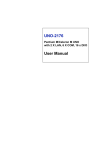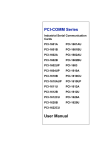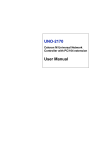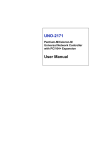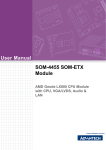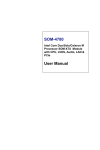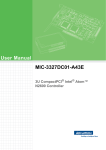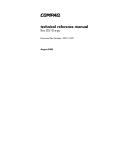Download UNO-4678 User Manual
Transcript
UNO-4678 Intel Celeron M Fanless Box PC with 3 x LAN, 8 x COM, PC/104 User Manual Copyright This document is copyrighted, © 2009. All rights are reserved. The original manufacturer reserves the right to make improvements to the products described in this manual at any time without notice. No part of this manual may be reproduced, copied, translated or transmitted in any form or by any means without the prior written permission of the original manufacturer. Information provided in this manual is intended to be accurate and reliable. However, the original manufacturer assumes no responsibility for its use, nor for any infringements upon the rights of third parties that may result from such use. Acknowledgements Intel, Pentium and Celeron are registered trademarks of Intel Corp. Microsoft Windows and MS-DOS are registered trademarks of Microsoft Corp. All other product names or trademarks are properties of their respective owners. Support For more information on this and other Advantech products, please visit our websites at: http://www.advantech.com For technical support and service, please visit our support website at: http://www.advantech.com/support/ This manual is for UNO-4678. Part No. 2003467801 2nd Edition Printed in Taiwan May 2009 UNO-4678 User Manual ii Product Warranty (2 years) Advantech warrants to you, the original purchaser, that each of its products will be free from defects in materials and workmanship for two years from the date of purchase. This warranty does not apply to any products that have been repaired or altered by persons other than repair personnel authorized by Advantech, or which have been subject to misuse, abuse, accident or improper installation. Advantech assumes no liability under the terms of this warranty as a consequence of such events. Because of Advantech high quality-control standards and rigorous testing, most of our customers never need to use our repair service. If an Advantech product is defective, it will be repaired or replaced at no charge during the warranty period. For out-of-warranty repairs, you will be billed according to the cost of replacement materials, service time and freight. Please consult your dealer for more details. If you think you have a defective product, follow these steps: Step 1. Collect all the information about the problem encountered. (For example, CPU speed, Advantech products used, other hardware and software used, etc.) Note anything abnormal and list any onscreen messages you get when the problem occurs. Step 2. Call your dealer and describe the problem. Please have your manual, product, and any helpful information readily available. Step 3. If your product is diagnosed as defective, obtain an RMA (return merchandize authorization) number from your dealer. This allows us to process your return more quickly. Step 4. Carefully pack the defective product, a fully completed Repair and Replacement Order Card and a photocopy proof of purchase date (such as your sales receipt) in a shippable container. A product returned without proof of the purchase date is not eligible for warranty service. Step 5. Write the RMA number visibly on the outside of the package and ship it prepaid to your dealer. iii CE This product has passed the CE test for environmental specifications. Test conditions for passing included the equipment being operated within an industrial enclosure. In order to protect the product from being damaged by ESD (Electrostatic Discharge) and EMI leakage, we strongly recommend the use of CE-compliant industrial enclosure products. FCC Class A This equipment has been tested and found to comply with the limits for a Class A digital device, pursuant to Part 15 of the FCC Rules. These limits are designed to provide reasonable protection against harmful interference when the equipment is operated in a commercial environment. This equipment generates, uses and can radiate radio frequency energy and, if not installed and used in accordance with the instruction manual, may cause harmful interference to radio communications. Operation of this equipment in a residential area is likely to cause harmful interference in which case the user will be required to correct the interference at his own expense. Technical Support and Assistance Step 1. Visit the Advantech web site at www.advantech.com/support where you can find the latest information about the product. Step 2. Contact your distributor, sales representative, or Advantech's customer service center for technical support if you need additional assistance. Please have the following information ready before you call: - Product name and serial number - Description of your peripheral attachments - Description of your software (OS, version, software, etc.) - A complete description of the problem - The exact wording of any error messages UNO-4678 User Manual iv Contents Chapter Chapter 1 Overview .......................................................... 2 1.1 1.2 1.3 1.4 Introduction ....................................................................... 2 Hardware Specifications ................................................... 4 Safety Precautions ............................................................. 6 Chassis Dimensions........................................................... 7 1.5 Packing List....................................................................... 8 Figure 1.1:Chassis Dimensions ...................................... 7 2 Hardware Functionality ............................... 10 2.1 2.2 Introduction ..................................................................... 10 Figure 2.1:Front Panel of UNO-4678 .......................... 10 Table 2.1:LED Definition ............................................ 10 Figure 2.2:Rear Panel .................................................. 11 RS-232/422/485 Interface (COM1~COM8) ................... 11 2.2.1 2.2.2 2.2.3 2.2.4 2.2.5 2.2.6 2.3 2.4 2.5 2.6 2.7 2.8 Chapter 16PCI954 UARTs with 128-byte standard .................. 11 RS-422/485 detection .................................................. 11 Automatic Data Flow Control Function for RS-485 ... 11 RS-232/422/485 Selection ........................................... 12 Figure 2.3:RS-422/485 jumper setting ......................... 12 Figure 2.4:RS-232 jumper setting ................................ 12 Auto Flow Control & Master/Slave Modes ................. 12 Termination Resistor (JP1 ~ JP8) ................................ 12 LAN: Ethernet Connector ............................................... 13 Power Input ..................................................................... 13 PS/2 Keyboard and Mouse Connector ............................ 13 USB Connector ............................................................... 13 VGA Display Connector ................................................. 14 Reset Button .................................................................... 14 3 Initial Setup.................................................... 16 3.1 3.2 3.3 3.4 Inserting a CompactFlash Card ....................................... 16 Connecting Power ........................................................... 16 Installing a Hard Disk ..................................................... 16 BIOS Setup and System Assignments ............................ 17 Appendix A System Settings and Pin Assignments ......... 20 A.1 UNO-4678 System I/O & Interrupt Assignments ......... 20 A.2 UNO-4678 System I/O & Interrupt Assignments ........... 22 A.3 RS-232/422/485 9pin Serial Port (COM1~COM2) ........ 24 A.4 RS-232/422/485 5-pin Serial Port (COM3~COM8) ....... 25 Table A.1: UNO-4678 System I/O Ports ...................... 20 Table A.2:UNO-4678 Interrupt Assignments............... 21 Table A.3: UNO-4678 System I/O Ports ...................... 22 Table A.4:UNO-4678 Interrupt Assignments............... 23 Table A.5:RS-232/422/485 pin assignments ............... 24 Table A.6:RS-232/422/485 pin assignments ............... 25 v Table of Contents A.5 A.6 Ethernet RJ-45 Connector (LAN1~LAN2)..................... 25 Power Screw Terminal (PWR)........................................ 26 A.7 PS/2 Keyboard and Mouse Connector ............................ 27 A.8 USB Connector (USB1~USB2) ...................................... 27 A.9 VGA Display Connector ................................................. 28 Figure A.1:Power Connector Pin Assignments ........... 26 Table A.8:Keyboard & mouse pin assignments ........... 27 Table A.9:USB connector pin assignments .................. 27 Table A.10:VGA adaptor cable pin assignment ........... 28 Appendix B Watchdog Timer Programming................... 30 B.1 UNO-4678....................................................................... 30 UNO-4678 User Manual vi CHAPTER 1 2 Overview This chapter provides an overview of UNO-4678’s specifications. Sections include: • Introduction • Hardware Specifications • Safety Precautions • Chassis Dmensions • Packing List Chapter 1 Overview 1.1 Introduction UNO-4678 is an embedded Application Ready Platform (ARP) that can shorten your development time and offers rich networking interfaces to fulfill extensive needs in different projects. Advantech Universal Network Controller is designed to be a total solution for network enabled Application Ready Platforms. Leveraging field-approved and worldwide approved real-time OS technology, Advantech UNO-4678 series provides a Windows CE .NET and Windows XP Embedded ready solution, and supports several standard networking interfaces, such as Ethernet, RS-232/422/485 and more. Because of its openness, great expansion capability and reliable design (fanless and diskless), the UNO-4678 series are ideal embedded platforms for implementing custom applications for diverse applications. Open Architecture Designed for Automation For applications demanding customized control, an UNO-4678 that uses more flexible, off-the-shelf technology is a better option. UNO-4678 uses off-the-shelf components such as an x86 processor, an Ethernet chip set, CompactFlash., and DRAM. At the same time, the UNO-4678 unit can broadcast the process data through the Ethernet and share the data with operators and managers. By using off-the-shelf components, machine builders can customize the control scheme they use for other machines that require multiple inputs, optimized control, or Ethernet communication. So, UNO-4678 offers the I/O connectivity of PCs with options like: 3 x 10/100Base-T Ethernet, 8 x RS-232/422/485, 2 x USB, CompactFlash and VGA interfaces for display panels. An Industry-Proven Design Industrial and mobile applications require controllers with high-vibration specifications and a wide temperature range. Machines or controllers in light industrial environments also require flexible and stable mounting. Many machine builders underestimate the need for a more rugged controller because their end applications are mounted in an industrial enclosure. UNO-4678 User Manual 2 Advantech UNO-4678 has a special design without the weaknesses of a standard PC. No fan, and no HDD prevent dust and vibration problems. With a smart mechanical design, UNO-4678 can meet 50 G shock (Use CompactFlash card ), 2 G vibration (Use CompactFlash card ), up to 50° C operating temperature and almost anything an industrial environment can demand. Designed to Fit Comfortably Into Racks In completely new packaging, UNO-4678 has standard 1U rack size as 440 x 220 x 44 mm (W x H x D) could fit your rack. You could easily mount UNO-4678 on rack and manage all UNOs in one rack and easily develop your application on rack. Flexible Networking Options The Advantech UNO-4678 offers two ways to connect to a network: Ethernet and Modem. The three built-in Ethernet ports provide highspeed networking capability up to 100 Mbps. And through UNO-4678’s isolated serial COM ports, you could link industrial modems to offer the most popular and easiest networking method by PSTN. Not only 8 channel serial COM port has 3 serial type but also provides surge and isolation protection up to 2,000VDC, protecting your system from abrupt high voltage attack and accident or damage in harsh environments. Popular Operating Systems and Rapid Application Development The Advantech UNO-4678 supports the popular off-the-shelf Microsoft Windows 2000/NT/XP operating systems and the Linux operating system. UNO-4678 also features pre-built Microsoft Windows XP embedded or Windows CE solutions offering a pre-configured image with optimized onboard device drivers. Microsoft Windows CE and XP Embedded are compact, highly efficient, and real-time operating systems that are designed for embedded systems without a HDD. There is no need to waste time and energy on developing onboard device drivers or using the Platform Builder to build a custom Windows CE image, they have all been done for the Advantech UNO-4678 series! Through the built-in runtime library and Software Development Kit (SDK), the UNO-4678 series leverages your existing Windows-based programming skills to rapidly develop applications. 3 Chapter 1 1.2 Hardware Specifications General Certifications CE, FCC Class A Dimensions (W x D x H) 1U (440 x 220 x 44 mm) (17.3” x 8.6” x 1.7”) Enclosure SECC Mounting Rack, wall Power Consumption 24 W (Typical) Power Input Min. 48 W (9 ~ 36 VDC) (e.g +24 V @ 2 A) Weight 3.6 kg OS Support Windows XP Embedded SP2, Windows 2000/ XP,Windows CE .NET 5.0, Linux System Hardware CPU Celeron M 1 GHz Indicators Power, Power input 1, Power input 2, Power fault, IDE, & all serial port Tx/Rx monitoring Keyboard/Mouse 1 x PS/2 Memory 512 MB DDR DRAM Storage SSD: 1 x internal type I/II CompactFlash slot HDD: Extension kit for one standard 2.5” HDD VGA DB15 VGA connector UNO-4678 User Manual 4 Communications Serial Ports Eight RS-232/422/485 ports include: - 2 x DB-9 connectors with 9-wired RS-232 - 6 x screw terminals with 5-wired RS-232 Automatic RS-485 data flow control 2000 VDC surge protection & isolation Serial Port Speed RS-232: 50 ~ 230.4 kbps RS-422/485: 50 ~ 921.6 kbps (Max.) LAN: 3 x 10/100Base-T RJ-45 ports USB Ports UNO-4678: 2 x USB, UHCI, Rev. 1.1 compliant UNO-4678: 2 x USB, UHCI, Rev. 2.0 compliant Environment Humidity 95% @ 40° C (non-condensing) Operating Temperature -10 ~ 50° C (14 ~ 122° F) Shock Protection IEC 68 2-27 CompactFlash: 50 G @ wall mount, half sine, 11 ms HDD: 20 G @ wall mount, half sine, 11 ms Vibration Protection IEC 68 2-64 (Random 1 Oct./min, 1hr/axis.) CompactFlash: 2 Grms @ 5 ~ 500 Hz, HDD: 0.5 Grms @ 5 ~ 500 Hz 5 Chapter 1 1.3 Safety Precautions The following,messages informs how to make each connection. In most cases, you will simply need to connect a standard cable. Warning! Always disconnect the power cord from your chassis whenever you are working on it. Do not connect while the power is on. A sudden rush of power can damage sensitive electronic components. Only experienced electronics personnel should open the chassis. Caution! Always ground yourself to remove any static electric charge before touching UNO-4678. Modern electronic devices are very sensitive to static electric charges. Use a grounding wrist strap at all times. Place all electronic components on a static-dissipative surface or in a static-shielded bag. Attention! If DC voltage is supplied by an external circuit, please put a protection device in the power supply input port. UNO-4678 User Manual 6 1.4 Chassis Dimensions Figure 1.1: Chassis Dimensions 7 Chapter 1 1.5 Packing List The accessory package of UNO-4678 contains the following items: (A) UNO-4678 (B) 2 x rack mounting kit (C) 8 x screw for rack mount kit (D) UNO series Driver and Utility CD-ROM (E) Keyboard/Mouse PS/2 cable (F) IDE cable for 2.5" HDD (G) 2.5" HDD expansion kit; 8 screws and 4 HDD expansion kit buffers UNO-4678 User Manual 8 CHAPTER 2 2 Hardware Functionality This chapter shows how to setup the UNO-4678’s hardware functions, including connecting peripherals, setting switches and indicators. Sections include: • Introduction • RS-232/422/485 Interface • LAN / Ethernet Connector • Power Connector • PS/2 Mouse and Keyboard Connector • USB Connector • VGA Display Connector • Reset Button Chapter 2 Hardware Functionality 2.1 Introduction The following two figures show the connectors on UNO-4678. The following sections give you detailed information about function of each peripheral. Figure 2.1: Front Panel of UNO-4678 Table 2.1: LED Definition Item LED Status Description 1 PWR 2 P1 3 P2 4 Fault 5 IDE 6 ACT On Off On Off On Off On Off On Off On Off On Off On Off On Off System power is on System power is off Power input 1 is active Power input 1 is inactive Power input 2 is active Power input 2 is inactive Power input 1 or Power input 2 have failed Power input 1 and Power input 2 are active Data being received/transmitted on IDE No data being received/transmitted on IDE Ethernet data being received/transmitted No data being received/transmitted 10/100Mbps Network links Invalid 10/100 Mbps Network link Serial port data being transmitted No data being transmitted Serial port data being received No data being received LINK 7 Tx (Port N) N = 1~ 8 Rx (Port N) N = 1~ 8 UNO-4678 User Manual 10 Figure 2.2: Rear Panel 2.2 RS-232/422/485 Interface (COM1~COM8) The UNO-4678 offers eight RS-232/422/485 serial communication interface ports: COM1 and COM8. Please refer to Appendix A.3 & A.4 for their pin assignments. The default settings of COM1 through COM8 are all RS-232. 2.2.1 16PCI954 UARTs with 128-byte standard Advantech UNO-4678 comes with 16PCI954 UARTs containing 128 byte FIFOs. 2.2.2 RS-422/485 detection In RS-422/485 mode, UNO-4678 automatically detects signals to match RS-422 or RS-485 networks. (No jumper change required) 2.2.3 Automatic Data Flow Control Function for RS-485 In RS-485 mode, UNO-4678 automatically detects the direction of incoming data and switches its transmission direction accordingly. So no handshaking signal (e.g. RTS signal) is necessary. This lets you conveniently build an RS-485 network with just two wires. More importantly, application software previously written for half duplex RS-232 environments can be maintained without modification. 11 Chapter 2 2.2.4 RS-232/422/485 Selection COM1 ~ COM8 support RS-232, RS-422 and RS-485 interfaces. The system detects RS-422 or RS-485 signals automatically in RS-422/485 mode. To select between RS-422/485 and RS-232 for COM1 ~ COM8, adjust JP3 ~ JP10. Jumper settings for RS-422/485 interface: (JP3 ~ JP10) A B C D E F G H I J Figure 2.3: RS-422/485 jumper setting Jumper settings for RS-232 interface: (Default setting) (JP3 ~ JP10) A B C D E F G H I J Figure 2.4: RS-232 jumper setting 2.2.5 Auto Flow Control & Master/Slave Modes You can set the “Auto Flow Control” mode of RS-485 or “Master/Slave” mode of RS-422 by using the SW2 DIP switch for each RS-422/485 port. In RS-485, if the switch is set to “Auto”, the driver automatically senses the direction of the data flow and switches the direction of transmission. No handshaking is necessary. In RS-422, if DIP switch is set to “On,” the driver is always enabled, and always in high or low status. 2.2.6 Termination Resistor (JP1 ~ JP8) The onboard termination resistor (120 ohm) for COM1 ~ COM8 (J1 ~ J8) can be used for long distance transmission or device matching. (Default Open.). COM Close A Enable TR for Data/TX Close B Enable TR for RX UNO-4678 User Manual 12 2.3 LAN: Ethernet Connector The UNO-4678 is equipped with a Realtek RTL8100 Ethernet LAN controller and UNO-4678 is equipped with a Realtek RTL8139 Ethernet LAN controller, which are fully compliant with IEEE 802.3u 10/ 100Base-T CSMA/CD standards. The Ethernet port provides a standard RJ-45 jack on board, and LED indicators on the front side to show its Link (Green LED) and Active (Yellow LED) status. 2.4 Power Input The UNO-4678 comes with a Phoenix connector that carries 9~36 VDC external power input, and features reversed wiring protection, it will not cause any damage to the system by reversed wiring of ground line and power line. Please refer to Appendix A.6 UNO-4678 supports two individual power inputs (P1/P2). If the voltage of power input < 9 VDC, it will switch to another power input and the FAULT LED will be enabled. 2.5 PS/2 Keyboard and Mouse Connector The UNO-4678 provides a PS/2 keyboard and PS/2 mouse connector. A 6-pin mini-DIN connector is located on the front panel of the UNO-4678. The UNO-4678 comes with an adapter to convert from the 6-pin miniDIN connector to two 6-pin mini-DIN connectors for PS/2 keyboard and PS/2 mouse connection. Please refer to Appendix A.7. 2.6 USB Connector The UNO-4678 provides two USB interface connectors, which provide complete Plug & Play and hot swapping for up to 127 external devices. The USB interface complies with USB UHCI, Rev. 1.1 compliant of UNO-4678. The USB interface complies with USB UHCI, Rev. 2.0 compliant of UNO-4678. The USB interface can be disabled in the system BIOS setup. Please refer to Appendix A.8 for its pin assignments. Note It is recommended that a CD-ROM attached by USB is used to install Windows or other operating systems. 13 Chapter 2 2.7 VGA Display Connector The UNO-4678 provides a VGA controller (Chipset VIA Twister chip with Integrated Savage4 2D/3K/Video Accelerator for a high resolution VGA interface. It supports up to 1280 x 1024 @ 32bpp (60Hz) / 1024 x 768 @ 32bpp (85Hz )and support 8/16/32 MB frame buffer with system memory. The UNO-4678 provides a VGA controller (Intel 855/852 GME, supports a single 1.5V accelerated graphics port interface) for a high resolution VGA interface. It supports CRT Mode: 1280 x 1024 @ 32bpp (60Hz), 1024 x 768 @ 32bpp (85Hz); LCD/Simultaneous Modes: 1280 x 1024 @ 16bpp(60Hz), 1024 x 768 @16bpp(60Hz) and up to 32 MB shared memory. 2.8 Reset Button Press the "Reset" button on the front panel to activate the reset function. UNO-4678 User Manual 14 CHAPTER 3 2 Initial Setup This chapter introduces how to initialize the UNO-4678. Sections include: • Inserting a CompactFlash Card • Conneting Power • Connecting a Hard Disk • BIOS Setup and System Assignments Chapter 3 Initial Setup 3.1 Inserting a CompactFlash Card UNO-4678 provides one CompactFlash slot. Following is the procedure for the installing a CompactFlash card (Slot CN7). Please follow these steps carefully. 1. Remove the power cord. 2. Unscrew the screws from the top cover of UNO-4678. 3. Remove the top cover. 4. Plug a CompactFlash card with your OS and application program into a CompactFlash card slot on board. 5. Screw back the top cover with screws. NOTE: CompactFlash disk (CN7) is Second IDE and HDD (CN5) is Primary IDE. 3.2 Connecting Power Connect the UNO-4678 to a 9~36 V DC power source. The power source can either be from a power adapter or an in-house power source. 3.3 Installing a Hard Disk Please follow these steps to install a hard disk into the UNO-4678. 1. Remove the power cord. 2. Unscrew the screws from the top cover of UNO-4678. 3. Remove the top cover. 4. Install the HDD in HDD bracket and screw on the HDD with the four screws. 5. Put HDD extension kit buffer on down cover of UNO-4678, and put HDD extension kit on four buffers and screw on it. 6. Connect the IDE flat cable to IDE connector (CN5), then connect the other side of the connector to the hard disk. 7. Screw back the top cover with screws. UNO-4678 User Manual 16 3.4 BIOS Setup and System Assignments UNO-4678 adopts Advantech’s SOM-4486 CPU module. Further information about the SOM-4486 CPU module, can be found in SOM-4486's user's manual. You can find this manual on the UNO-4678's driver and utility CD-ROM. Please note that you can try to “LOAD BIOS DEFAULTS” from the BIOS Setup manual if the UNO-4678 does not work properly. 17 Chapter 3 UNO-4678 User Manual 18 Appendix A System Settings and Pin Assignments Appendix A System Settings and Pin Assignments A.1 UNO-4678 System I/O & Interrupt Assignments Table A.1: UNO-4678 System I/O Ports Address Range Device 000-01F DMA controller (slave) 020-03F Interrupt controller 1, (master) 040-05F 8254 timer/counter 060-06F 8042 (keyboard controller) 070-07F Real-time clock, non-maskable interrupt (NMI)mask 080-09F DMA page register, 0A0-0BF Interrupt controller 2 (slave) 0C0-0DF DMA controller (master) 0F0 Clear math co-processor 0F1 Reset math co-processor 0F8-0FF Math co-processor 1F0-1F8 1st fixed disk 278-27F Reserved 380-38F SDLC, bisynchronous 2 3A0-3AF Bisynchronous 1 3B0-3BF Monochrome display 3C0-3CF Reserved 3D0-3DF Color/graphics monitor adapter 3F0-3F7 Diskette controller 443 Watchdog timer UNO-4678 User Manual 20 Table A.2: UNO-4678 Interrupt Assignments Interrupt No. Interrupt Source NMI Parity error detected IRQ 0 Interval timer IRQ 1 Keyboard IRQ 2 Interrupt from controller 2 (cascade) IRQ 3 Free IRQ 4 Free IRQ 5 Free IRQ 6 Diskette controller (FDC) IRQ 7 Free IRQ 8 Real-time clock IRQ 9 Free IRQ 10 Free IRQ 11 Reserved for watchdog timer IRQ 12 PS/2 mouse IRQ 13 INT from co-processor IRQ 14 Primary IDE IRQ 15 Secondary IDE for CompactFlash 21 Appendix A A.2 UNO-4678 System I/O & Interrupt Assignments Table A.3: UNO-4678 System I/O Ports Address Range Device 000-01F DMA controller (slave) 020-03F Interrupt controller 1, (master) 040-05F 8254 timer/counter 060-06F 8042 (keyboard controller) 070-07F Real-time clock, non-mask interrupt (NMI) 080-09F DMA page register, 0A0-0BF Interrupt controller 2 (slave) 0C0-0DF DMA controller (master) 0F0 Clear math co-processor 0F1 Reset math co-processor 0F8-0FF Math co-processor 1F0-1F8 1st fixed disk 278-27F Reserved 380-38F SDLC, bisynchronous 2 3A0-3AF Bisynchronous 1 3B0-3BF Monochrome display 3C0-3CF Reserved 3D0-3DF Color/graphics monitor adapter 3F0-3F7 Diskette controller UNO-4678 User Manual 22 Table A.4: UNO-4678 Interrupt Assignments Interrupt No. Interrupt Source NMI Parity error detected IRQ 0 Interval timer IRQ 1 Keyboard IRQ 2 Interrupt from controller 2 (cascade) IRQ 3 Free IRQ 4 Free IRQ 5 Free IRQ 6 Diskette controller (FDC) IRQ 7 Free IRQ 8 Real-time clock IRQ 9 Free IRQ 10 Free IRQ 11 Free IRQ 12 PS/2 mouse IRQ 13 INT from co-processor IRQ 14 Primary IDE IRQ 15 Secondary IDE for CompactFlash 23 Appendix A A.3 RS-232/422/485 9pin Serial Port (COM1~COM2) 1 2 3 4 5 6 7 8 9 Table A.5: RS-232/422/485 pin assignments Pin RS-232 RS-422 RS-485 1 DCD Tx- Data- 2 Rx Tx+ Data+ 3 Tx Rx+ - 4 DTR Rx- - 5 GND GND GND 6 DSR - - 7 RTS - - 8 CTS - - 9 RI - - UNO-4678 User Manual 24 A.4 RS-232/422/485 5-pin Serial Port (COM3~COM8) Table A.6: RS-232/422/485 pin assignments Pin RS-232 RS-422 RS-485 1 Rx Tx+ Data+ 2 Tx Tx- Data- 3 RTS Rx+ - 4 CTS Rx- - 5 GND GND GND A.5 Ethernet RJ-45 Connector (LAN1~LAN2) Table A.7: Ethernet RJ-45 connector pin assignments Pin 10/100Base-T Signal Name 1 XMT+ 2 XMT- 3 RCV+ 4 NC 5 NC 6 RCV- 7 NC 8 NC 25 Appendix A A.6 Power Screw Terminal (PWR) Figure A.1: Power Connector Pin Assignments Pin Signal Name VIN Power input 1; Range: 9~ 36VDC VBAT power input 2; Range: 9~ 36VDC GND Ground RLP1 Internal relay Normal status: Close, Fail Status: Open RLP2 Note: 1. UNO-4678 supports two individual power inputs (VIN/VBAT). If the voltage of the power input < 9 VDC, it will switch to another power input and the FAULT LED will be enabled. 2. RPL1/ RPL2 is internal relay and can be used for remote monitor,the standard mode is " Close", if one of input power got fail, it will be " Open" UNO-4678 User Manual 26 A.7 PS/2 Keyboard and Mouse Connector 6 5 4 3 2 1 Table A.8: Keyboard & mouse pin assignments Pin Signal Name 1 KB DATA 2 MS DATA 3 GND 4 VCC 5 KB Clock 6 MS Clock A.8 USB Connector (USB1~USB2) Table A.9: USB connector pin assignments Pin Signal Name Cable Color 1 VCC Red 2 DATA+ White 3 DATA- Green 4 GND Black 27 Appendix A A.9 VGA Display Connector 5 1 10 6 15 11 Table A.10: VGA adaptor cable pin assignment Pin Signal Name 1 Red 2 Green 3 Blue 4 NC 5 GND 6 GND 7 GND 8 GND 9 NC 10 GND 11 NC 12 NC 13 H-SYNC 14 V-SYNC 15 NC UNO-4678 User Manual 28 Appendix Programming the Watchdog Timer B Appendix B Watchdog Timer Programming B.1 UNO-4678 Below is a sample of programming code for controlling the Watchdog Timer function. ----------------------------------------------------------------------------------Enter the extended function mode, interruptible double-write | ----------------------------------------------------------------------------------MOV DX,2EH MOV AL,87H OUT DX,AL OUT DX,AL ----------------------------------------------------------------------------Configured logical device 8, configuration register CRF6 | ----------------------------------------------------------------------------MOV DX,2EH MOV AL,2BH OUT DX,AL MOV DX,2FH IN AL,DX AND AL.OEFH;Setbit 4=0 Pin 89=WDTO OUT DX,AL MOV DX,2EH MOV AL,07H; point to Logical Device Number Reg. OUT DX,AL MOV DX,2FH MOV AL,08H; select logical device 8 OUT DX,AL; MOV DX,2EH MOV AL,30H;Set watch dog activate or inactivate UNO-4678 User Manual 30 OUT DX,AL MOV DX,2FH MOV AL,01H; 01:activate 00:inactivate OUT DX,AL; MOV DX,2EH MOV AL,F5H; Setting counter unit is second OUT DX,AL MOV DX,2FH MOV AL,00H OUT DX,AL; MOV DX,2EH MOV AL,F6H OUT DX,AL MOV DX,2FH MOV AL,05H; Set 5 seconds OUT DX,AL ;-----------------------------------------; Exit extended function mode | ;-----------------------------------------MOV DX,2EH MOV AL,AAH OUT DX,AL 31 Appendix B UNO-4678 User Manual 32






































